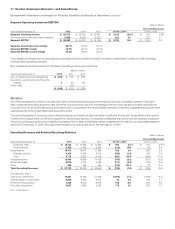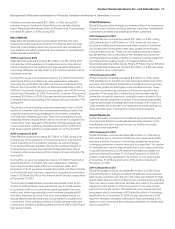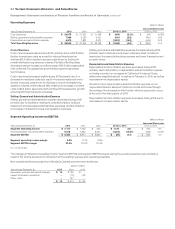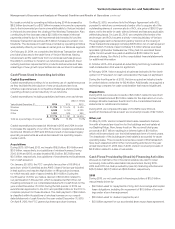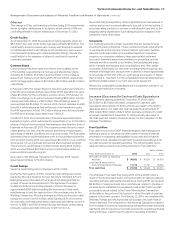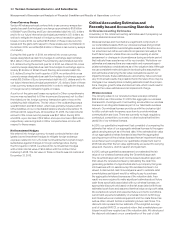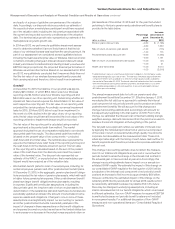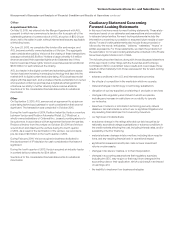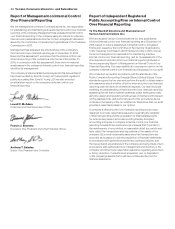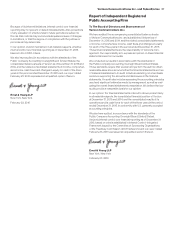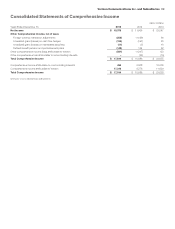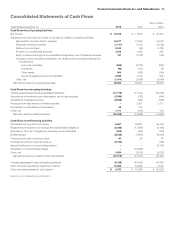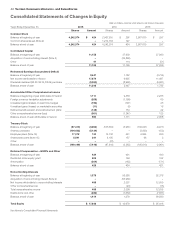America Online 2015 Annual Report Download - page 34
Download and view the complete annual report
Please find page 34 of the 2015 America Online annual report below. You can navigate through the pages in the report by either clicking on the pages listed below, or by using the keyword search tool below to find specific information within the annual report.Cross Currency Swaps
Verizon Wireless previously entered into cross currency swaps des-
ignated as cash flow hedges to exchange approximately $1.6billion
of British Pound Sterling and Euro- denominated debt into U.S. dollars
and to fix our future interest and principal payments in U.S. dollars, as
well as to mitigate the impact of foreign currency transaction gains or
losses. In June 2014, we settled $0.8billion of these cross currency
swaps and the gains with respect to these swaps were not material. In
December 2015, we settled $0.6billion of these cross currency swaps
on maturity.
During the first quarter of 2014, we entered into cross currency
swaps designated as cash flow hedges to exchange approximately
$5.4billion of Euro and British Pound Sterling denominated debt into
U.S. dollars. During the second quarter of 2014, we entered into cross
currency swaps designated as cash flow hedges to exchange approx-
imately $1.2billion of British Pound Sterling denominated debt into
U.S. dollars. During the fourth quarter of 2014, we entered into cross
currency swaps designated as cash flow hedges to exchange approxi-
mately $3.0billion of Euro denominated debt into U.S. dollars and to fix
our future interest and principal payments in U.S. dollars. Each of these
cross currency swaps was entered into in order to mitigate the impact
of foreign currency transaction gains or losses.
A portion of the gains and losses recognized in Other comprehensive
income was reclassified to Other income and (expense), net to offset
the related pre-tax foreign currency transaction gain or loss on the
underlying debt obligations. The fair value of the outstanding swaps
was $1.6billion and $0.6billion, which was primarily included within
Other liabilities on our consolidated balance sheets at December31,
2015 and 2014, respectively. At December31, 2015, the total notional
amount of the cross currency swaps was $9.7billion. During 2015
and 2014, a pre-tax loss of $1.2billion and a pre-tax loss of $0.1billion,
respectively, was recognized in Other comprehensive income with
respect to these swaps.
Net Investment Hedges
We entered into foreign currency forward contracts that are des-
ignated as net investment hedges to mitigate foreign exchange
exposure related to non-U.S. dollar net investments in certain foreign
subsidiaries against changes in foreign exchange rates. During
the third quarter of 2015, we entered into net investment hedges
with a total notional value of $0.9billion with the contract tenor
maturing in 2018. The fair value of these contracts was not material at
December31, 2015.
Critical Accounting Estimates and
Recently Issued Accounting Standards
Critical Accounting Estimates
A summary of the critical accounting estimates used in preparing our
financial statements is as follows:
• Wireless licenses and Goodwill are a significant component of
our consolidated assets. Both our wireless licenses and goodwill
are treated as indefinite-lived intangible assets and, therefore are
not amortized, but rather are tested for impairment annually in the
fourth fiscal quarter, unless there are events requiring an earlier
assessment or changes in circumstances during an interim period
that indicate these assets may not be recoverable. We believe our
estimates and assumptions are reasonable and represent appro-
priate marketplace considerations as of the valuation date. Although
we use consistent methodologies in developing the assumptions
and estimates underlying the fair value calculations used in our
impairment tests, these estimates are uncertain by nature and can
vary from actual results. It is possible that in the future there may be
changes in our assumptions, including estimated cash flow projec-
tions, margins, growth rates and discount rate, which could result in
different fair value estimates and an impairment charge.
Wireless Licenses
The carrying value of our wireless licenses was approximately
$86.6billion as of December31, 2015. We aggregate our wireless
licenses into one single unit of accounting, as we utilize our wireless
licenses on an integrated basis as part of our nationwide wireless
network. Our wireless licenses provide us with the exclusive right
to utilize certain radio frequency spectrum to provide wireless
communication services. There are currently no legal, regulatory,
contractual, competitive, economic or other factors that limit the
useful life of our wireless licenses.
In 2015, our quantitative impairment test consisted of comparing the
estimated fair value of our aggregate wireless licenses to the aggre-
gated carrying amount as of the test date. If the estimated fair value
of our aggregated wireless licenses is less than the aggregated
carrying amount of the wireless licenses then an impairment charge
would have been recognized. Our quantitative impairment test for
2015 indicated that the fair value significantly exceeded the carrying
value and, therefore, did not result in an impairment.
In 2015, using a quantitative assessment, we estimated the fair
value of our wireless licenses using the Greenfield approach.
The Greenfield approach is an income based valuation approach
that values the wireless licenses by calculating the cash flow
generating potential of a hypothetical start-up company that goes
into business with no assets except the wireless licenses to be
valued. A discounted cash flow analysis is used to estimate what
a marketplace participant would be willing to pay to purchase
the aggregated wireless licenses as of the valuation date. As a
result, we were required to make significant estimates about future
cash flows specifically associated with our wireless licenses, an
appropriate discount rate based on the risk associated with those
estimated cash flows and assumed terminal value and growth rates.
We considered current and expected future economic conditions,
current and expected availability of wireless network technology
and infrastructure and related equipment and the costs thereof as
well as other relevant factors in estimating future cash flows. The
discount rate represented our estimate of the weighted- average
cost of capital (WACC), or expected return, that a marketplace par-
ticipant would have required as of the valuation date. We developed
the discount rate based on our consideration of the cost of debt
32 Verizon Communications Inc. and Subsidiaries
Management’s Discussion and Analysis ofFinancialCondition and Results of Operations continued


